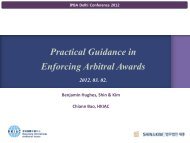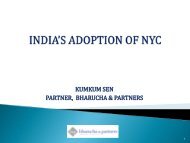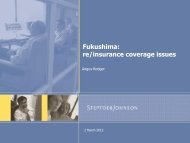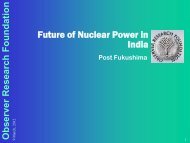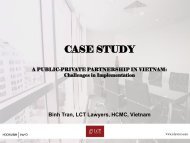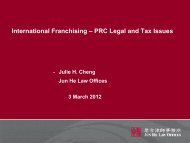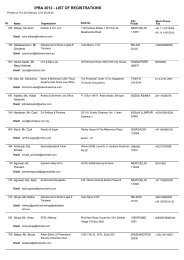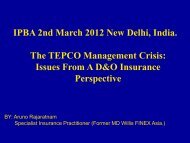U.S Nuclear Policy and Clean Tech After Fukushima ... - IPBA 2012
U.S Nuclear Policy and Clean Tech After Fukushima ... - IPBA 2012
U.S Nuclear Policy and Clean Tech After Fukushima ... - IPBA 2012
- No tags were found...
Create successful ePaper yourself
Turn your PDF publications into a flip-book with our unique Google optimized e-Paper software.
U.S <strong>Nuclear</strong> <strong>Policy</strong> <strong>and</strong> <strong>Clean</strong> <strong>Tech</strong><br />
<strong>After</strong> <strong>Fukushima</strong> Daiichi:<br />
A Brief Overview<br />
Inter-Pacific Bar Association<br />
22 nd Annual Conference<br />
March 2, <strong>2012</strong><br />
Douglas A. Codiga, Esq.<br />
Schlack Ito LLLC<br />
Honolulu, Hawaii, USA
<strong>Nuclear</strong> Energy in the<br />
United States
U.S. <strong>Nuclear</strong> Reactors – Current<br />
Largest fleet of nuclear reactors<br />
Largest consumer of nuclear power<br />
104 nuclear reactors in 31 states<br />
4 different reactor vendors <strong>and</strong> 26 operating companies<br />
80 different designs<br />
65 sites<br />
35 boiling water reactors <strong>and</strong> 69 pressurized water reactors<br />
19.6% of U.S. net electric generation or 807 billion kWh of<br />
electricity<br />
23 Mark 1 (first generation) boiling water reactors – same as<br />
<strong>Fukushima</strong> Daiichi
U.S. <strong>Nuclear</strong> Reactors – Proposed<br />
U.S. <strong>Nuclear</strong> Regulatory Commission recently approved licenses<br />
for two new reactors in Georgia - first new licenses since 1978<br />
NRC Chair Jaczko dissent: “I cannot support issuing this license<br />
as if <strong>Fukushima</strong> never happened”<br />
1,100 MW Westinghouse AP1000 pressurized water reactors<br />
$8.3 billion federal loan guarantee under Energy <strong>Policy</strong> Act of<br />
2005<br />
Federal tax credit up to $250 million annually for first 8 years of<br />
operation<br />
Ratepayer surcharge of $44 per year increasing to $120 by 2018
U.S. <strong>Nuclear</strong> Reactors – Proposed<br />
In 2010, U.S. Dept. of Energy projected only six plants<br />
would come online by 2035 due to high costs <strong>and</strong><br />
natural gas supplies<br />
Cost as high as $10 billion per plant with 50% risk of<br />
default<br />
St<strong>and</strong>ard <strong>and</strong> Poor’s: nuclear rebirth unlikely at this<br />
time<br />
World <strong>Nuclear</strong> Association predicts gradual decline in<br />
number of operating units over the next two decades
Obama Administration<br />
Response
Public Support Declines<br />
Public support for nuclear energy dropped after the<br />
<strong>Fukushima</strong> Daiichi incident<br />
Lowest support since the Three Mile Isl<strong>and</strong> incident in 1979<br />
Approval dropped to 45% from the 60% approval rating in<br />
2008<br />
Political leaders express concerns<br />
U.S. Senator Barbara Boxer: “Japan is a technologically<br />
capable country, <strong>and</strong> they anticipated earthquakes <strong>and</strong><br />
tsunamis, but still they didn't have all the failsafes to stop this<br />
tragedy from occurring”
Obama Continues to<br />
Support <strong>Nuclear</strong> Energy<br />
Congressional testimony by Energy Secretary Steven Chu<br />
U.S. position on nuclear energy “hasn’t changed”<br />
United States “must rely on a diverse sources including<br />
nuclear power”<br />
In 2011, Obama proposed increasing nuclear federal loan<br />
guarantee to $54.5 billion<br />
Obama established “Blue Ribbon Commission on America’s<br />
<strong>Nuclear</strong> Future” under U.S. Dept. of Energy<br />
Proposed FY 2013 budget requests $27.5 billion for U.S.<br />
Dept. of Energy, including $770 million for nuclear energy
“I'm determined to ensure that it's<br />
safe. So in light of what's happened in<br />
Japan, I've requested a comprehensive<br />
safety review by the <strong>Nuclear</strong><br />
Regulatory Commission to make sure<br />
that all of our existing nuclear energy<br />
facilities are safe. And we're going<br />
incorporate those conclusions <strong>and</strong><br />
lessons from Japan in design <strong>and</strong> the<br />
building of the next generation of<br />
plants. But we can't simply take it off<br />
the table.”<br />
President Obama<br />
Georgetown University<br />
March 30, 2011
Response of<br />
<strong>Nuclear</strong> Regulatory Commission
NRC Background<br />
Established by Energy Reorganization Act of 1974<br />
Regulations in Title 10 of Code of Federal Regulations<br />
Independent regulatory agency created by U.S.<br />
Congress<br />
Licenses design, construction, operation <strong>and</strong><br />
decommissioning of commercial nuclear power plants<br />
5 Commissioners appointed by President with no<br />
more than 3 from each political party<br />
NRC Office of <strong>Nuclear</strong> Reactor Regulation
Japan Task Force<br />
NRC established the Japan Task Force in April 2011<br />
Mission of the JTF is to examine NRC’s “regulatory<br />
requirements, programs <strong>and</strong> processes” in light of<br />
<strong>Fukushima</strong> Daiichi<br />
JTF to identify near-term <strong>and</strong> longer term actions<br />
July 12, 2011 report concluded “a sequence of events like<br />
the <strong>Fukushima</strong> accident is unlikely to occur in the United<br />
States” <strong>and</strong> “continued operation <strong>and</strong> continued licensing<br />
activities do not pose an imminent risk to public health <strong>and</strong><br />
safety”
JTF Recommendations<br />
Replace NRC’s “patchwork of regulatory<br />
requirements” developed piecemeal over decades<br />
with “logical, systematic <strong>and</strong> coherent regulatory<br />
framework”<br />
Require nuclear plants to upgrade seismic <strong>and</strong><br />
flooding protection<br />
For Mark I reactors, strengthen station blackout<br />
mitigation capability, including reliable hardened vent<br />
designs
Impact on U.S. <strong>Clean</strong> <strong>Tech</strong><br />
<strong>Policy</strong>
• U.S. Energy Information Agency<br />
reports renewable energy<br />
provided 12% of U.S. energy as of<br />
Sept. 2011<br />
• <strong>Nuclear</strong> provided 10.6% - less than<br />
renewables (including hydro)<br />
• Obama FY 2013 budget proposes<br />
$946 million for clean tech,<br />
including R&D, clean coal, battery<br />
storage<br />
• March 2011 “Blueprint for a Secure<br />
Energy Future”
State Policies Promote <strong>Clean</strong> <strong>Tech</strong><br />
No major federal energy legislation presently anticipated<br />
from U.S. Congress<br />
U.S. States promote aggressive clean tech policies<br />
California<br />
Renewable Portfolio St<strong>and</strong>ard - 33% by 2020<br />
Global Warming Solutions Act (AB 32)<br />
New Jersey<br />
Property Assessed <strong>Clean</strong> Energy<br />
Hawaii<br />
Hawaii <strong>Clean</strong> Energy Initiative – 70% by 2030
Conclusions<br />
No major changes to U.S. nuclear policy post-<br />
<strong>Fukushima</strong> Daiichi<br />
Obama Administration continues to support nuclear<br />
energy, despite decreased public support<br />
Regulatory response by NRC is major focus<br />
<strong>Clean</strong> tech sector promoted by U.S. federal support<br />
<strong>and</strong> aggressive U.S. state policies
Thank You<br />
Douglas A. Codiga, Esq.<br />
Schlack Ito LLLC<br />
Honolulu, Hawaii, USA





